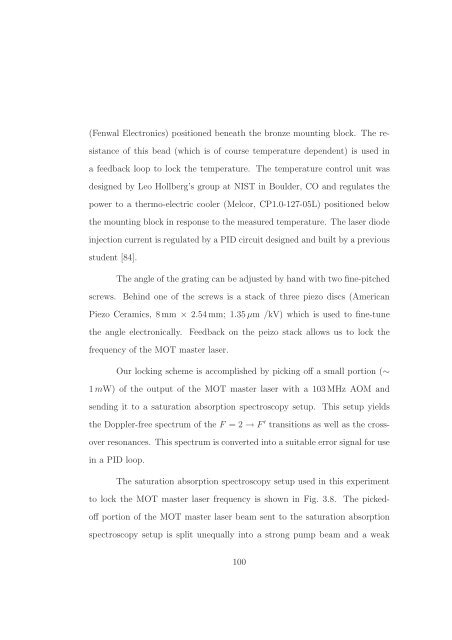Single-Photon Atomic Cooling - Raizen Lab - The University of ...
Single-Photon Atomic Cooling - Raizen Lab - The University of ...
Single-Photon Atomic Cooling - Raizen Lab - The University of ...
Create successful ePaper yourself
Turn your PDF publications into a flip-book with our unique Google optimized e-Paper software.
(Fenwal Electronics) positioned beneath the bronze mounting block. <strong>The</strong> re-<br />
sistance <strong>of</strong> this bead (which is <strong>of</strong> course temperature dependent) is used in<br />
a feedback loop to lock the temperature. <strong>The</strong> temperature control unit was<br />
designed by Leo Hollberg’s group at NIST in Boulder, CO and regulates the<br />
power to a thermo-electric cooler (Melcor, CP1.0-127-05L) positioned below<br />
the mounting block in response to the measured temperature. <strong>The</strong> laser diode<br />
injection current is regulated by a PID circuit designed and built by a previous<br />
student [84].<br />
<strong>The</strong> angle <strong>of</strong> the grating can be adjusted by hand with two fine-pitched<br />
screws. Behind one <strong>of</strong> the screws is a stack <strong>of</strong> three piezo discs (American<br />
Piezo Ceramics, 8 mm × 2.54 mm; 1.35µm /kV) which is used to fine-tune<br />
the angle electronically. Feedback on the peizo stack allows us to lock the<br />
frequency <strong>of</strong> the MOT master laser.<br />
Our locking scheme is accomplished by picking <strong>of</strong>f a small portion (∼<br />
1mW) <strong>of</strong> the output <strong>of</strong> the MOT master laser with a 103 MHz AOM and<br />
sending it to a saturation absorption spectroscopy setup. This setup yields<br />
the Doppler-free spectrum <strong>of</strong> the F = 2 → F ′ transitions as well as the cross-<br />
over resonances. This spectrum is converted into a suitable error signal for use<br />
in a PID loop.<br />
<strong>The</strong> saturation absorption spectroscopy setup used in this experiment<br />
to lock the MOT master laser frequency is shown in Fig. 3.8. <strong>The</strong> picked-<br />
<strong>of</strong>f portion <strong>of</strong> the MOT master laser beam sent to the saturation absorption<br />
spectroscopy setup is split unequally into a strong pump beam and a weak<br />
100
















